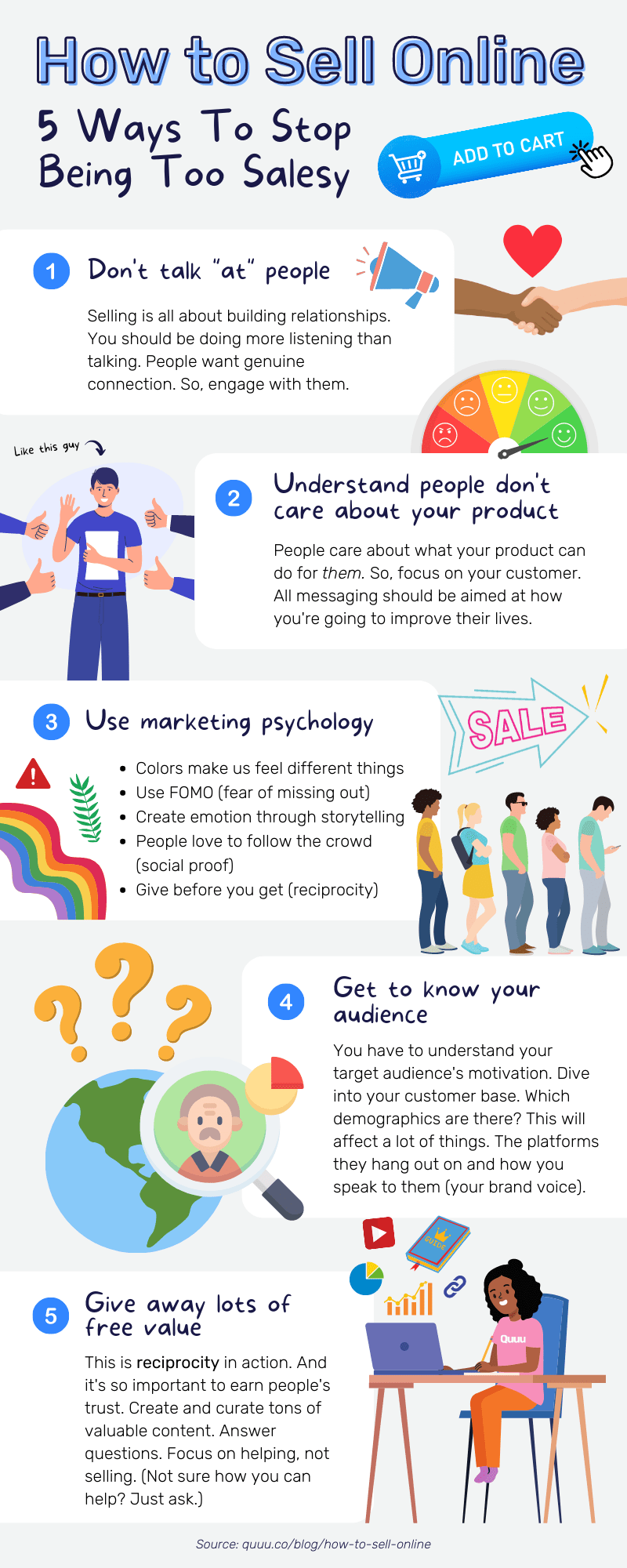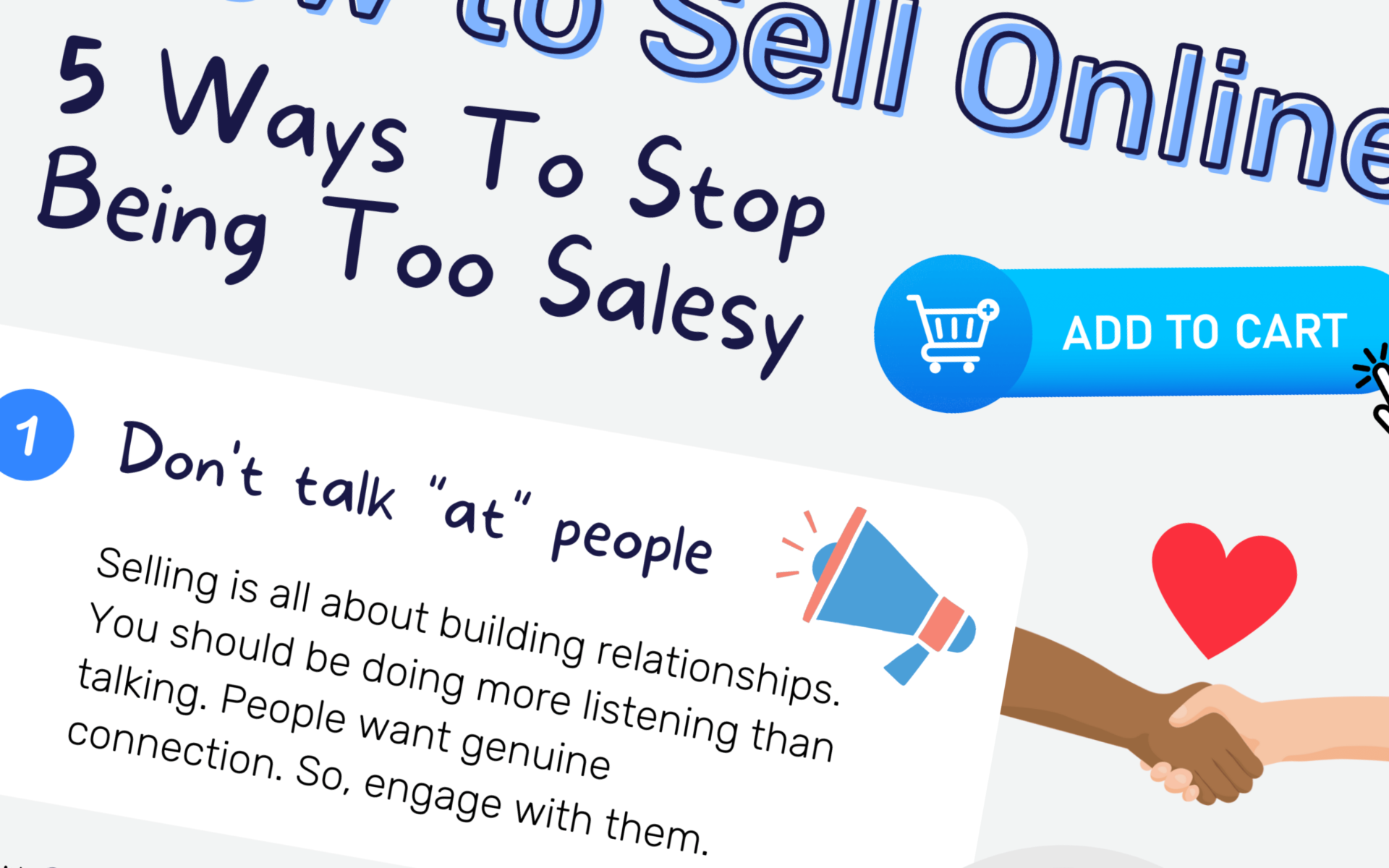You need tips on how to sell online. So, you must have something worth selling. But it’s not easy these days. Even the best salespeople struggle.
People love to buy. But they hate to be sold to. That’s the idea behind indirect marketing. And that’s what these tactics are based on.
The internet is overflowing with products and services. So, choice is almost unlimited. But standing out doesn’t mean shouting about how great you are. Actually, it’s the opposite.
Here are 5 ways to stop being so salesy:
- Don’t talk “at” people
- Understand people don’t care about your product
- Use marketing psychology tactics
- Get to know your target audience
- Give away a lot of free value

Focus on social media over Amazon and eBay
Everyone’s customer journey is different. It’s not really a funnel anymore. And there are tons of different touchpoints.

Source: SuperOffice
So, this is a bit of a different guide on how to sell online. I’m not focusing on eCommerce websites like Amazon. Etsy, or eBay. Potential buyers are already in the zone there. They’re ready to part with their cash or credit card deets.
I want to focus on the stages before online stores. Your company website. Your social media platforms. The places where people aren’t even sure they’re a consumer yet. But you’re gonna make ‘em be.
You have to speak to people in a different way here. And a lot of it will rely on your brand voice. But as well as how you say it, I want to look at what you say.
So, let’s start with that.
1. Don’t talk “at” people
Entrepreneurs are full of great ideas for new products. But that doesn’t always mean they make great sales reps.
Yes, how to sell is about knowing your product inside out. But it’s also important to know how to get that across. And it’s definitely not by constantly saying how great it is.

Source: GIPHY
Selling is building relationships. It’s about creating genuine connections with people. And it’s mostly listening.
This is something most people forget on social media. We all want engagement on our profiles. But to get, you’ve gotta give. Social media engagement takes a lot of effort to increase. And you’ll need to do a lot of it yourself.
So, how do you do it? Well, here are a few ways to connect with your customers:
- Be really active on social media
- Personalize your sales process
- Respond to every comment
- Ask for feedback
- Make your core values clear (and stick to them!)
- Follow up on complaints
- Show your appreciation for loyalty and new customers
Starbucks is great at this:
Don’t ever just send off a bunch of generic templates. And don’t overuse automation either. People want a personal touch. Even with online businesses. It’s pretty much expected nowadays.
2. Understand people don’t care about your product
I’m sorry, guys. This is a tough pill to swallow regarding how to sell. But it’s true. People don’t care about your product. Or your profit margins and bottom line. They just don’t.
But (and it’s a big but) they do care about what it’ll do for them. How it’s going to affect their lives. So, it’s an easy switch. All messaging should be focused on the customer.
Here’s what I mean:
Basically, it’s all in your copy. It’s how you word everything your customer sees. You’re putting yourself in their shoes. You want to involve them in the narrative.

Source: Marketing Examples
Every detail is important. Even your CTA (call to action) buttons on your site:

Source: Twitter
Each of the above examples come from knowing your customers. You understand some of the reasons stopping them signing up. So, you know how to fix it.
Do they think the process will take too long? “Try in 5 minutes.” Are they wary of entering card details? “Start free.”
This applies to eCommerce businesses too. Your product features descriptions should follow this logic. Check out this example from Oodie:


It’s clothing. But it appeals to plant lovers. And they feel like they’re doing good by buying it.
It’s not hard to move away from what makes your product so great. And instead, focus on how it fits into people’s lives. You just have to get creative with your copy.
3. Use marketing psychology tactics
All humans have cognitive biases. These are instinctual ways of thinking. And they help us make quick decisions in real-time. Marketing psychology taps into these. And can make how you sell way more subtle.
Have you heard of the decoy effect? Maybe not by name. But you’ll have experienced it. It’s all to do with our perception of pricing:
Imagine you’ve got 2 products in front of you. The 2nd seems expensive in comparison. But then a pricier 3rd option is added. The 2nd now seems pretty reasonable, right?

Source: Sketchplanations
By adding a decoy, people convince themselves to buy the previously pricier option. You’ve not had to suggest anything.
You can use these tactics on your site and social media platforms. As well as the content itself. Some popular options are:
- Color psychology – they create different reactions (e.g. red grabs attention, green feels natural)
- FOMO (fear of missing out) – limited time offers and sales spark urgency
- Storytelling – this can create powerful emotions which inspire us to take action
- Social proof – success stories or case studies give us confidence to follow the crowd
- Reciprocity – we want to respond to a positive action with one of our own
Here’s social proof using a big name:

Source: StreamYard
So, what are some other ways we can put this psychology into action? Here are a few examples:
- A blue company website could feel more trustworthy
- Labeling your best-selling products encourages FOMO
- Clips from war-torn countries inspire charity donations
- Add reviews to your site so people feel more comfortable buying
- Have an awesome educational blog attached to your site (more on that in section 5!)
All of these tactics are low-key. But you won’t believe how much of an impact they can have.
4. Get to know your target audience
Ask yourself: who is it you’re selling to? Do you know the answer? This is kinda the most important question if you don’t. Because you’ll be basing how to sell on it.
It’ll be easier if you’ve already got a CRM (customer relationship management) system set up. Because you’ve got data to base this on.
Startups and small businesses will have a harder time finding this out. There has to be research involved. Dig into your competitors. Search on social media. Create customer personas. Whatever works.

Source: Adzooma
You need to ask yourself:
- Which demographics are you targeting?
- Where are they from?
- Where do they hang out online?
- Are they more active on LinkedIn or Instagram? Why?
Once you have this info, you need to go deeper. You have to understand potential customers’ needs. These will be things like:
- What motivates them to buy
- Their biggest pain points
- What price they can afford
- How they want your product/service to function
As copy Queen Joanna Wiebe said:
There are tons of ways to do this. You can use social listening tools to find people’s comments about your brand. You can also ask them directly in surveys. Also, check out your reviews (if you ask for them).
All these will give you everything you need to build a picture of your customer base. And once you know that, you’ve got everything you need to succeed.
5. Give away a lot of free value to your followers/subscribers
Free value. This is what most sales processes are missing. But it boils down to something simple. Trust.
Remember those marketing psychology tactics? This is reciprocity in action. By giving something, people naturally want to give back.
You can’t expect people to part with their hard-earned cash if they don’t trust you. And if you’re a new company building a brand, you’re starting from scratch.
It’s easy to get attention with a paid ad. It’s hard to earn trust.

Source: Webwalrus
Now, “free value” doesn’t have to mean giving away your service for nothing. Yes, it can be a free trial. But there are tons of other ways to help out potential customers:
- Educational content (video tutorials, how-to articles, newsletters, etc.)
- Answering questions on social media
- Having great customer support
- Partnerships with other brands (e.g. social media takeovers)
- Giveaways and contests
#1 is going to be key here. Content marketing and SEO (search engine optimization) go hand in hand. But even Google doesn’t just “trust” new sites. It has to check your content is authentic and consistent first. Once it has, it’ll index you.

Source: Quuu
Not sure how you can help your target audience? Or what they’ll find valuable? Why not ask them? It’ll give you more chances to engage on social media too.
Being a provider of free value won’t cost anything. But you will have to spend some valuable time. Though it’s definitely worth it.
Conclusion
If you’re wondering how to sell online, there are a lot of guides out there. But most breeze over the most obvious factor: people don’t like being sold to.
So, your job is to sell without being too salesy. Especially on social media, where most people aren’t really there to buy. These 5 ways can help:
- Don’t talk “at” people
- Understand they don’t care about your product
- Use marketing psychology tactics
- Get to know your target audience
- Give away lots of free value
Any purchase has to feel like your customer’s choice. So, don’t be pushy. Get to know your buyers. Then create clever copy and helpful content. And let them come to you.
What kind of content would your audience enjoy? Which of these tactics are most important? Share your thoughts in the comments below.





